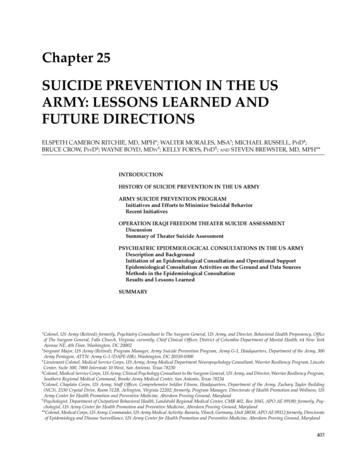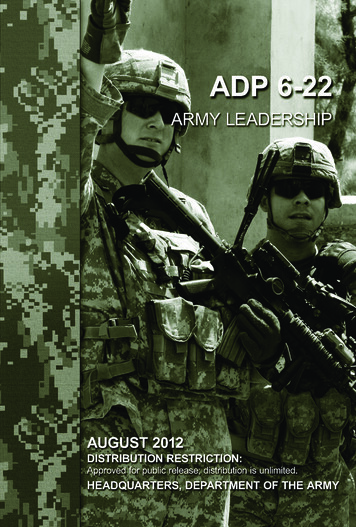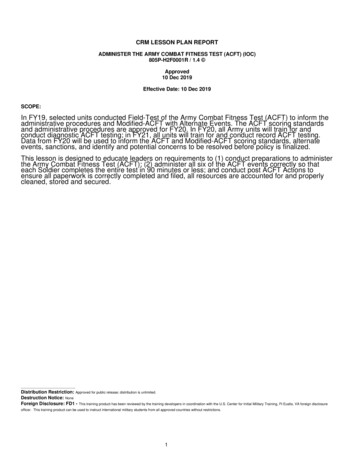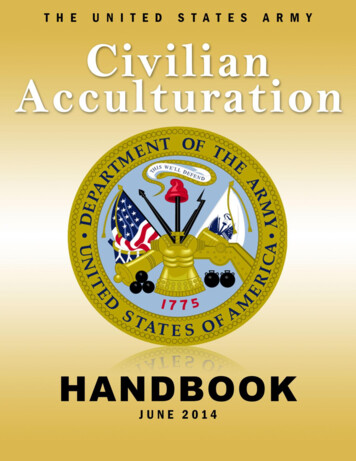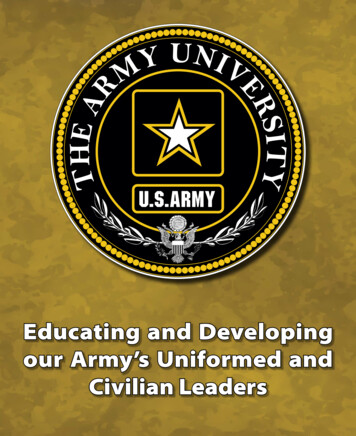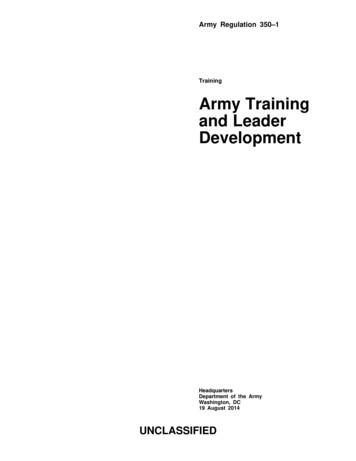
Transcription
Army Regulation 350–1TrainingArmy Trainingand LeaderDevelopmentHeadquartersDepartment of the ArmyWashington, DC19 August 2014UNCLASSIFIED
SUMMARY of CHANGEAR 350–1Army Training and Leader DevelopmentThis major revision, dated 19 August 2014-oEstablishes Individual Development Plan management and the Army CareerTracker; expands Multi-Source Assessment and Feedback; establishes the ArmyLearning Product Development by introducing analysis, design, development,implementation and evaluation (ADDIE)and eliminates Army Training andEducation Development (ATED); removes the combined list of Army TrainingStrategy and Army Leader Development Strategy goals; removes reference toArmy Training and Leader Development Strategy and Army Training and LeaderDevelopment Guidance; establishes the Army Leader Development Forum whichreplaces the Quarterly Leader Development Review (chap 1).oModifies responsibilities of U.S. Army Forces Command and Office of theChief, Army Reserve based on realignment of U.S. Army Reserve Command;deletes Eighth U.S. Army; adds U.S. Army Cyber Command; removes U.S. ArmyForces Command responsibility as Army service component command for JointForces Command (chap 2).oRenames and restructures the Noncommissioned Officer Education System byreplacing Basic Noncommissioned Officer Course with Advanced Leaders Course,and Advanced Noncommissioned Officers’ Course with Senior Leaders Course;renames and restructures Officer Education System by replacing Basic OfficerLeaders Course I, II, and III with Basic Officer Leaders Course A and B,renames Warrant Officer courses; modifies the entry on DA Form 1059 for APFTfailure from achieved marginal course standards to failed course standards;changes the profile waiver criteria to an exception to policy for WarrantOfficer Candidate School and Officer Candidate School; changes the approvallevel for senior service college deferments for lieutenant colonel(promotable) and colonel; deletes the First Sergeant Course adding theCompany Commander First Sergeant Course; aligns Warrior Leader Course toNoncommissioned Officer Education System (chap 3).oRevises and restructures the Civilian Education System; establishes generalpolicy and guidance for the overall administration of Army civilian trainingprograms, including identifying authorities that govern civilian training;clarifies requirements for maintaining civilian training records anddocumentation; clarifies authorized resources and expenses which may be usedto support civilian training; identifies centrally managed civilian trainingcourses/programs (chap 3).oClarifies the source for mandatory training in units; adds unit levelcollective training terms of reference; revises troop schools (chap 4).oRevises and establishes new training standards for language and culturaltraining (chap 8).
oAdds requirement of formal inspection of individual training records. Changesmaintenance of individual training records from manual to documentation inDigital Training Management System (app F).oRevises table G-1 to reflect only reoccurring mandatory training in unitscommon to all Soldiers in a unit; establishes conditions for exemptions tomandatory training; validates the U.S. Army Forces Command-published predeployment training guidance messages and identifies other Army trainingprograms; addresses mandatory training for selected personnel; increasesresilience training requirements; replaces sexual harassment training andsexual assault prevention and response training with Sexual Harassment /Assault Response and Prevention Program training; adds requirement for ArmyValues training; adds requirement for Deputy Chief of Staff, G-2 initialorientation and annual refresher information security training (app G).oAdds internal control evaluation (app M).oAdds glossary terms pertaining to Training Support System management andexecution for execution commands, execution support commands, seniorcommander, mission commander, and supported commands; and mandatory trainingand command-directed training (glossary).oMakes administrative changes (throughout).
*Army Regulation 350–1HeadquartersDepartment of the ArmyWashington, DC19 August 2014Effective 19 September 2014TrainingArmy Training and Leader Developmentthe Administrative Assistant to the Secretary of the Army.History. This regulation is a majorrevision.Summary. This regulation consolidatespolicy and guidance for Army trainingand leader development and support Armydecisive actions in Unified LandOperations.Applicability. This regulation applies tothe Active Army, the Army NationalGuard/Army National Guard of the UnitedStates, and the U.S. Army Reserve, unlessotherwise stated. It also applies to Department of the Army civilian employees.During mobilization, the proponent maymodify the policies and procedures contained in this regulation provided that themodification is coordinated with and concurred with by the Administrative Assistant to the Secretary of the Army and thatthe modification is disseminated throughContentsProponent and exception authority.The proponent of this regulation is theDeputy Chief of Staff, G–3/5/7. The proponent has the authority to approve exceptions or waivers to this regulation thatare consistent with controlling law andregulations. The proponent may delegatethis approval authority, in writing, to adivision chief within the proponentagency or its direct reporting unit or fieldoperating agency, in the rank of colonelor the civilian equivalent. Activities mayrequest a waiver to this regulation by providing justification that includes a fullanalysis of the expected benefits and mustinclude formal review by the activity’ssenior legal officer. All waiver requestswill be endorsed by the commander orsenior leader of the requesting activityand forwarded through their higher headquarters to the policy proponent. Refer toAR 25–30 for specific guidance.Army internal control process. Thisregulation contains internal control provisions in accordance with AR 11–2 andidentifies key internal controls that mustbe evaluated (see app M).Supplementation. Supplementation ofthis regulation and establishment of command and local forms are prohibited without prior approval from the Deputy Chiefof Staff, G–3/5/7 (DAMO–TR), Washington, DC 20310–0450.improvements on DA Form 2028 (Recommended Changes to Publications andBlank Forms) directly to the Office of theDeputy Chief of Staff, G–3/5/7(DAMO–TR), 450 Army Pentagon,Washington, DC 20310–0450.Committee management. AR 15–1 requires the proponent to justify establishing/continuing committee(s), coordinatedraft publications, and coordinate changesin committee status with the U.S. ArmyResources and Programs Agency, Department of the Army Committee Management Office (AARP–ZA), 9301 ChapekRoad, Building 1458, Fort Belvoir, VA22060–5527. Further, if it is determinedthat an established “group” identifiedwithin this regulation, later takes on thecharacteristics of a committee, as found inthe AR 15–1, then the proponent will follow all AR 15–1 requirements for establishing and continuing the group as acommittee.Distribution. This publication is available in electronic media only and is intended for command levels C, D, and Efor the Active Army, the Army NationalGuard/Army National Guard of the UnitedStates, and the U.S. Army Reserve.Suggested improvements. Users areinvited to send comments or suggested(Listed by paragraph and page number)Chapter 1Introduction, page 1Section IOverview, page 1Purpose 1–1, page 1*This regulation supersedes AR 350–1, dated 18 December 2009.AR 350–1 19 August 2014UNCLASSIFIEDi
Contents—ContinuedReferences 1–2, page 1Explanation of abbreviations and terms 1–3, page 1Responsibilities 1–4, page 1Section IIArmy Mission and Force Generation, page 1Army mission and strategic goal 1–5, page 1The modular force 1–6, page 1Army Force Generation 1–7, page 1Section IIIGoals of Army Training, page 2The training challenge 1–8, page 2Army training and leader development goals 1–9, page 2Army training and leader development 1–10, page 2Training domains 1–11, page 2Section IVArmy Training and Leader Development Processes, page 4The Army Training System 1–12, page 4Authorities and responsibilities for training 1–13, page 4Army Learning Product Development 1–14, page 5The Army training management process 1–15, page 5Training Support System 1–16, page 6Leader development 1–17, page 7Training standardization 1–18, page 8Conducting training in units and schools 1–19, page 8Managing training in units 1–20, page 8Managing training in Army schools 1–21, page 9Section VArmy Training Programs, page 10Oversight of Army training programs 1–22, page 10Physical readiness training 1–23, page 10The Combat Training Center Program 1–24, page 10Section VITraining and Education Schools, page 10The Army School System 1–25, page 10One Army School System 1–26, page 10Schools of other government organizations 1–27, page 11Inter-service training 1–28, page 11Chapter 2Responsibilities, page 11Section IHeadquarters, Department of the Army, page 11Assistant Secretary of the Army (Acquisition, Logistics, and Technology) 2–1, page 11Assistant Secretary of the Army (Installations, Energy and Environment) 2–2, page 12Assistant Secretary of the Army (Manpower and Reserve Affairs) 2–3, page 12Chief Information Officer/G–6 2–4, page 12Assistant Chief of Staff for Installation Management 2–5, page 12Office of the Chief of Staff Army, Director, Senior Leader Development Office 2–6, page 13Deputy Chief of Staff, G–1 2–7, page 13Deputy Chief of Staff, G–2 2–8, page 15iiAR 350–1 19 August 2014
Contents—ContinuedDeputy Chief of Staff, G–3/5/7 2–9, page 15Deputy Chief of Staff, G–4 2–10, page 18Deputy Chief of Staff, G–8 2–11, page 19Chief, National Guard Bureau 2–12, page 19Chief, Army Reserve 2–13, page 21The Inspector General 2–14, page 22Chief of Public Affairs 2–15, page 22The Surgeon General 2–16, page 22The Judge Advocate General 2–17, page 23Chief of Chaplains 2–18, page 23Chief of Engineers 2–19, page 23Provost Marshal General 2–20, page 23Commanders of Army commands, Army service component commands, and direct reporting units 2–21, page 24Section IIArmy Commands, page 26Commanding General, U.S. Army Training and Doctrine Command 2–22, page 26Commanding General, U.S. Army Forces Command 2–23, page 32Commanding General, U.S. Army Materiel Command 2–24, page 33Section IIIArmy mandingCommandingCommandingCommandingComponent Commands, page 34General, U.S. Army, Europe 2–25, page 34General, U.S. Army Pacific 2–26, page 34General, U. S. Army South 2–27, page 34General, U. S. Army North 2–28, page 35General, U.S. Army Central Command 2–29, page 35General, U.S. Army Special Operations Command 2–30, page 35General, U.S. Army Space and Missile Defense Command/Army Strategic 2–31, page 35General, Military Surface Deployment and Distribution Command 2–32, page 36Section IVDirect Reporting Units and Other Commands, page 36Commanding General, U.S. Army Corps of Engineers 2–33, page 36Commanding General, U.S. Army Medical Command 2–34, page 36Commanding General, U.S. Army Intelligence and Security Command 2–35, page 36Commanding General, U.S. Army Criminal Investigation Command 2–36, page 37Commanding General, U.S. Army Military District of Washington 2–37, page 37Commanding General, Installation Management Command 2–38, page 37Superintendent, U.S. Military Academy 2–39, page 37Commanding General, U.S. Army Network Enterprise Technology Command/9th Signal 2–40, page 37Commanding General, U.S. Army Test and Evaluation Command 2–41, page 38Director, U.S. Army Acquisition Support Center 2–42, page 38Commanding General, U.S. Army Cyber Command 2–43, page 38Other commanders and leaders 2–44, page 38Senior commander and garrison commander duties 2–45, page 39Section VProponent School Commandants/Commanders, page 40Commandants and commanders of Army schools 2–46, page 40Approval responsibilities for programs of instruction/courses at special schools 2–47, page 42Chapter 3The Army Institutional Training and Education System, page 42AR 350–1 19 August 2014iii
Contents—ContinuedSection IIntroduction, page 42Description 3–1, page 42One Army School System 3–2, page 42The Army School System 3–3, page 43Army training and education proponents 3–4, page 44Section IIAdministration, page 45Army Quality Assurance Program requirements 3–5, page 45Course information 3–6, page 47Conduct of Training and Training locations 3–7, page 47HQDA Mandatory training in institutions 3–8, page 47Conduct of instruction 3–9, page 47Eligibility 3–10, page 48Incurred obligations 3–11, page 49Selection of Soldiers and Army Civilians for training and education 3–12, page 50Physical readiness and height and weight requirements for military institutional training 3–13, page 52Physical profiles 3–14, page 54Student dismissal 3–15, page 55Removal from course consideration or selection lists 3–16, page 57Deferment 3–17, page 57Declinations 3–18, page 58Officer and noncommissioned officer professional military education backlog definitions 3–19, page 59Course credit 3–20, page 59Operational Credit Program 3–21, page 60Early release/early graduation from the Officer Education System/Noncommissioned Officer 3–22, page 61Education and training evaluation 3–23, page 62Student education and training records 3–24, page 62Documentation of course/training completion 3–25, page 62Academic evaluation report 3–26, page 63Section IIIInitial Military Training, page 63Initial Military Training 3–27, page 63Initial Entry Training for Prior Service 3–28, page 65Section IVOfficer Training and Education, page 66The Officer Education System 3–29, page 66Warrant officer education requirements 3–30, page 67Officer education requirements 3–31, page 68Pre-commissioning/Pre-appointment programs 3–32, page 68Basic Officer Leadership Course Phases A (Pre-commissioning) and B (Branch) 3–33, page 68Warrant Officer Advanced Course 3–34, page 69Captains Career Courses 3–35, page 70Warrant Officer Staff Course / Warrant Officer Intermediate Level Education 3–36, page 70Intermediate Level Education 3–37, page 70Advanced Military Studies Program 3–38, page 74Command Team and Key Billet Training and Education 3–39, page 74Warrant Officer Senior Staff Course / Warrant Officer Senior Service Education 3–40, page 77Senior Service Colleges 3–41, page 77U.S. Army War College 3–42, page 77Advanced Strategic Leadership Studies Program 3–43, page 78Army War College Fellowship Program 3–44, page 78ivAR 350–1 19 August 2014
Contents—ContinuedSchools of Other Nations 3–45, page 78General Officer training 3–46, page 80Section VNoncommissioned Officer Training and Education, page 82Noncommissioned Officer Education System 3–47, page 82Noncommissioned Officer Education System requirements 3–48, page 83Structured Self Development 3–49, page 83Noncommissioned officer academies 3–50, page 83Warrior Leader Course 3–51, page 84Advanced Leaders Course 3–52, page 84Senior Leaders Course 3–53, page 85Sergeants Major Course 3–54, page 85Command Sergeant Major Brigade and Battalion Pre-Command Course and Command Sergeant Major DevelopmentProgram 3–55, page 86Section VIMilitary Functional, Specialty and Other Training, page 86Military Functional area and skill training 3–56, page 86Ranger training 3–57, page 86Airborne training 3–58, page 87Equal Opportunity Management training 3–59, page 87Battle Staff Noncommissioned Officer Course 3–60, page 88Advanced Strategic Planning and Policy Program 3–61, page 88Joint education and training institutions 3–62, page 88Section VIICivilian Education, page 88Civilian Leader Development 3–63, page 88The Civilian Education System 3–64, page 88Foundation Course 3–65, page 89Basic Course 3–66, page 89Intermediate Course 3–67, page 89Advanced Course 3–68, page 90Continuing Education for Senior Leaders 3–69, page 90Action Officer Development Course 3–70, page 91Supervisor Development Course 3–71, page 91Manager Development Course 3–72, page 91Mandatory Supervisory Training for Civilian and Military Supervisors 3–73, page 91Senior Enterprise Talent Management Program 3–74, page 91Senior Service College 3–75, page 92Defense Senior Leader Development Program 3–76, page 93Graduate Placement Program for Senior Service College and Defense Senior Leader Development Program 3–77,page 94Defense Executive Leadership Development Program 3–78, page 94Senior Executive Service Education, Training and Development 3–79, page 94Section VIIICivilian Functional, Specialty and Other Training, page 96Training and Developing the Army Civilian Corps 3–80, page 96Training Records and Documentation 3–81, page 96Supervisors and Managers 3–82, page 97Resourcing Civilian Training 3–83, page 97Authorized Training Expenses 3–84, page 97Repayment of Training Expenses 3–85, page 98AR 350–1 19 August 2014v
Contents—ContinuedContinued Service Agreement 3–86, page 98Outside the Continental United States Training for Employees Stationed in the Continental United States 3–87,page 99Non Government Training Sources 3–88, page 99Prohibited Practices 3–89, page 100Training During the Duty Day 3–90, page 100Conferences and Workshops 3–91, page 100Credentials and Certifications 3–92, page 101Competitive Professional Development 3–93, page 101Academic Degree Training 3–94, page 103Army Congressional Fellowship Program 3–95, page 103Leadership for a Democratic Society at the Federal Executive Institute 3–96, page 104Harvard University Program for Senior Executive Fellows 3–97, page 105Senior Manager Course in National Security Leadership 3–98, page 105Senior Leader Seminar: Senior Leader Development Course 3–99, page 106Section IXGeneral Functional, Specialty and Other Training, page 106Civilian institutions 3–100, page 106Contract training courses 3–101, page 107Sabbaticals 3–102, page 107Exception to Civilian Training Policy Requests 3–103, page 107Chapter 4Training in Units and Organizations, page 107Section IPlanning Unit Training, page 107The command climate and leadership 4–1, page 107Sergeant’s Training Time 4–2, page 108Assessments and evaluations of performance 4–3, page 108Recording military training 4–4, page 109HQDA Mandatory training in units 4–5, page 109Collective Training - Terms of Reference 4–6, page 109Pre-deployment and redeployment training requirements 4–7, page 110Section IITraining and Leader Development in Units, page 111General policy 4–8, page 111Officer Professional Development 4–9, page 111Noncommissioned Officer Development Program 4–10, page 111Airborne training in units 4–11, page 112Army Combatives Program 4–12, page 113Chemical, Biological, Radiological, and Nuclear defense training 4–13, page 113Troop Schools Training 4–14, page 113Intelligence Training and readiness 4–15, page 114Chapter 5Training Support System, page 114Purpose 5–1, page 114Training Support System Products, Services, and Facilities 5–2, page 114Training Support System Program Components 5–3, page 115Training Support System Organization 5–4, page 116Training Support System Enterprise 5–5, page 116Training Support System Management and Execution 5–6, page 117viAR 350–1 19 August 2014
Contents—ContinuedTraining Support System Requirements Generation 5–7, page 119Training Support System Sustainment and Maintenance 5–8, page 119Training Support System Metrics and Capability Assessment 5–9, page 119Chapter 6Army Modernization Training, page 120Section IIntroduction, page 120Policies and procedures 6–1, page 120Army modernization by unit sets 6–2, page 120Total package fielding 6–3, page 120Rapid equipment acquisition, fielding and testing 6–4, page 120Acquisition of training support 6–5, page 120General acquisition objectives for training 6–6, page 121Required training and training support 6–7, page 121Provision of training and training support 6–8, page 122Training developer determines requirements for new equipment training and doctrine and tactics training 6–9,page 124Section IINew Equipment Training, page 124New equipment training objective 6–10, page 124New equipment training policy 6–11, page 125Planning for new equipment training 6–12, page 125New equipment training planning considerations 6–13, page 126Contractual requirements 6–14, page 126Developing training support components 6–15, page 127Conducting new equipment training 6–16, page 127Termination of new equipment training 6–17, page 128Funding for new equipment training 6–18, page 128New equipment training documentation 6–19, page 128Agencies requiring new equipment training 6–20, page 128Reserve Component considerations 6–21, page 130Section IIIDisplaced equipment, page 130Displaced equipment training determination 6–22, page 130Reserve Component displaced equipment determination 6–23, page 130Section IVDoctrine and Tactics Training, page 130Doctrine and tactics training summary 6–24, page 130Doctrine and tactics training policy 6–25, page 130Planning for doctrine and tactics training 6–26, page 131Sustainment training coordination 6–27, page 131Sustainment training policy 6–28, page 131Sustainment training planning and execution 6–29, page 131Chapter 7The Army Distributed Learning Program, page 132Section IIntroduction, page 132Description 7–1, page 132General 7–2, page 132AR 350–1 19 August 2014vii
Contents—ContinuedTraining and education through distributed learning 7–3, page 132Distributed Learning courses 7–4, page 133Army e-Learning 7–5, page 133Section IIDeveloping and Implementing Distributed Learning, page 133Distributed learning governance; approval process for distributed learning courseware development 7–6, page 133Distributed learning development prioritization 7–7, page 134Distributed learning implementation 7–8, page 134Course information 7–9, page 135Training 7–10, page 135Eligibility 7–11, page 135Selection and enrollment 7–12, page 135Compensation of the Selected Reserve of the Ready Reserve personnel for electronic-based Distributed Learning 7–13, page 136Course credit 7–14, page 138Student dismissal 7–15, page 138Section IIIDL Facilities, page 138Modifications to Digital training facilities 7–16, page 138Digital training facilities and distributed learning classroom utilization procedures 7–17, page 138Maintenance and administration 7–18, page 139Chapter 8Culture and Language, page 140Section IIntroduction, page 140Purpose 8–1, page 140References 8–2, page 140Cultural Capability and Language Proficiency 8–3, page 140Training categories 8–4, page 140Section IICultural Capability, page 140Responsibilities 8–5, page 140Terms 8–6, page 140Cultural capability levels 8–7, page 141Cultural capability evaluation 8–8, page 141Cultural training domains 8–9, page 141Section IIILanguage Proficiency, page 142Responsibilities 8–10, page 142Language training domains 8–11, page 142Language education and training documentation 8–12, page 143AppendixesA.References, page 144B.The Learning Product Development Process, page 155C.Military Schools, Colleges, and Training Centers, page 157D.Prerequisites and Service Obligation Incurred by Attendance at Foreign Military Schools, page 159viiiAR 350–1 19 August 2014
Contents—ContinuedE.Noncommissioned Officer Academy Designations and Regions and Active Army Regional Quota Managers,page 161F.Training Records, page 164G.Army Training Programs, page 166H.Joint Airborne/Air Transportability Training, page 193I.Constructive or Equivalent Course Credit for Officers and Army Civilians, page 195J.List of Reimbursable New Equipment Training Support and Services, page 199K.Multi-Source Assessment and Feedback, page 199L.Culture and Language Resources, page 202M. Internal Control Evaluation, page 203Table ListTable 3–1: Matrix of Initial Entry Training Attendance for Prior Service Personnel (Addressing Break-in-Service),page 66Table 3–2: ILE Requirements for Other Service Assessed and Government Civilian Graduates (for officers in YearGroup or Commission Year 94 and subsequent year groups), page 73Table 3–3: Army Brigade and Battalion Pre-command Course (PCC) Attendance Policy, page 75Table 6–1: Responsibility for Training Development and Support If Needed for the Conduct of New EquipmentTraining/Doctrine and Tactics Training, page 123Table 6–2: Responsibility for Providing with Materiel Fielding the Training Support Components needed forSustainment Training after any NET/DTT, page 124Table B–1: Analysis, design, development, implementation, and evaluation process, page 156Table D–1: Schools that equate to U.S. Senior Service Colleges, page 160Table D–2: Schools that equate to Command and General Staff Officer Course, page 160Table E–1: Noncommissioned Officer Academy regions, page 162Table E–2: Addresses of regional quota managers, page 164Table G–1: Headquarters, Department of the Army Mandatory Training Requirements for all Personnel in Units,page 167Table G–2: Headquarters, Department of the Army Mandatory Training Subjects Taught in Training Institutions,page 168Table G–3: Headquarters, Department of the Army Mandatory Training Requirements for Army Civilians, page 170Table I–1: Constructive or equivalent course credit for Officer Personnel Management Directorate—-managed ActiveArmy commissioned officers, page 195Table I–2: Constructive or equivalent course credit for chaplains, page 196Table I–3: Constructive or equivalent course credit for AMEDD (MC, DC, VC, AN, MSSP) officers, page 197Table I–4: Constructive or equivalent course credit for Judge Advocate General Corps officers, page 197Table I–5: Constructive or equivalent course credit for Army Civilian Corps, page 198GlossaryAR 350–1 19 August 2014ix
Chapter 1IntroductionSection IOverview1–1. PurposeThis regulation prescribes policies, procedures, and responsibilities for developing, managing, and conducting Armytraining and leader development.1–2. ReferencesRequired and related publications and prescribed and referenced forms are listed in appendix A.1–3. Explanation of abbreviations and termsAbbreviations and special terms used in this regulation are explained in the glossary.1–4. ResponsibilitiesResponsibilities are listed in chapter 2.Section IIArmy Mission and Force Generation1–5. Army mission and strategic goalThe Army’s mission is to build forces capable of Unified Land Operations, able to operate effectively with Joint,interagency, intergovernmental and multinational partners across the range of military operations to provide capableand ready forces to combatant commanders (CCDRs) in support of the National Security and National DefenseStrategies, while sustaining and maintaining the quality of the All-volunteer Force. The Army’s Strategic Goal is toprovide the Joint Force Commander (JFC) with forces prepared to seize, retain, and exploit the initiative to gain andmaintain a position of relative advantage in sustained land operations through simultaneous offensive, defensive, andstability or defense support of civil authorities operations in order to prevent or deter conflict, prevail in war, and createthe conditions for favorable conflict resolution. Training must address the Joint context and follow the concepts andimplementation guidelines in Department of Defense (DOD) Training Transformation.1–6. The modular forceTo meet requirements of current operations and anticipated future missions, the Army restructured operating forces inall components of the Army into operational headquarters and modular brigades - Armored, Stryker, and Infantrybrigade combat teams, multifunctional support brigades (aviation, maneuver enhancement, battlefield surveillance,fires, and sustainment), functional and theater brigades. Modularity enables the Army to assign a set of Army modularbrigades to an operational headquarters to accomplish a specific mission and to synchronize the allocation of resourcesto ensure their readiness. The Army’s intent behind the modular force is for the active Army (AA) to provide rapidlyresponsive, agile and expeditionary forces that typically respond within the first 30 days of an operation. Theavailability of sufficient AA and reserve component (RC) forces will provide the Joint Force commander the capabilities necessary to achieve operational and strategic objectives and to conduct sustained land combat.1–7. Army Force GenerationThe Army Force Generation (ARFORGEN) process established in AR 525–29 is the structured progression of unitreadiness over time to produce trained, ready and cohesive units prepared for operational deployment in support of aCCDR and other Army requirements. The ARFORGEN process is the Army’s core process for force generationcycling units through three phases: Reset, Train/Ready, and Available. Each of the three phases contains a balancedforce capability to provide a sustained flow of forces for current commitments and to hedge against unexpectedcontingencies. ARFORGEN establishes the basis to plan and execute Army-wide unit resourcing. As a model,ARFORGEN supports the Army’s planning, programming, budgeting, and execution (PPBE) process. As a process, itsynchronizes the Army’s efforts to provide land forces and other capabilities required by our Nation.a. The Reset Phase offers the units and individuals the opportunity to focus training on: Soldier-Family reintegration; block leave; unit reconstitution; changes of command; behavioral health, medical and dental readiness; professiona
Army training and leader development † 1-10, page 2 Training domains † 1-11, page 2 Section IV Army Training and Leader Development Processes, page 4 The Army Training System † 1-12 .





